
Along the waistband, whether appendix up front or somewhere around the back, is the concealed-carry convention of the day for a reason, given the speed that a carry piece can be presented and the relative ease of hiding it there. For most people, and in most circumstances, this is your optimal option for concealing a gun on the go and should be considered the “Plan A” mode of carry. But life is rarely optimal, and a carry method that requires a bit more compromise is still infinitely preferable to wishful thinking with a “finger gun.”
There are many reasons why someone might need to find a “Plan B” carry option. Some, like a medical condition, may be permanent (or at least long-term), while others might just be situational—like wanting to find a more convenient way to arm yourself while exercising or driving. And, as with most things, it may just come down to personal preference or comfort.
In my case, back issues have always precluded me from carrying concealed in a common waistband-adjacent location—if I carried my primary CCW (a Kimber R7 Mako) for eight hours today in the most comfortable inside-the-waistband (IWB) holster in the world, I would spend all of tomorrow in a horizontal position, hopped up on muscle relaxants. I can make it work for a short period of time if I know I’m going to be standing all day, but my spine can’t abide long hours seated, contorted with a gun jabbing me in the kidney. Which is what compelled me years ago to seek out less-conventional, but still valid, means of concealed carry in the first place—and three of the most common methods of carry not centered around the waistband are shoulder holsters, belly-band holsters and ankle holsters.
None of the three is particularly popular these days, although the belly band does currently seem to be on the upswing, but each of these types do have both areas where they excel and foibles that concealed carriers will need to learn to overcome or circumvent when considering them. Of course, that rarity does also lend these carry methods something of an extra element of surprise—a criminal savvy enough to be on the lookout for the subtle printing of a pistol secreted away at 5 o’clock may completely overlook the one hidden up your pant leg. And, of course, since none of these are belt-dependent, they aren’t mutually exclusive with waistband carry, and may therefore present a great option for you as a mode of carry for a backup pistol.
Compared to the smorgasbord of available IWB and OWB holsters, examples of all three will also be considerably scarcer to find on the market. Don’t get me wrong, there’s no shortage of great options out there from makers both large and small, but these are specialized carry niches that many holster companies disregard entirely, so it may take a bit more effort to find what you’re looking for in a fit for your chosen carry piece. In all three cases, as with pretty much any type of holster, there’s a broad quality/price spectrum at play here—in shoulder holsters, for example, inexpensive nylon options with minimal retention can be had for as little as $25 and lavishly adorned leather options can run you close to $500.
These days, I am primarily a practitioner of another compromise carry option, pocket carry, which has been rendered far more practical in recent years with the emergence of pocketable 9 mm micro-compacts. However, since it was covered by Layne Simpson in these pages last year in “Notes On Practical Handgun Carry” (February 2023, p. 56), I will not re-tread that ground here. Across-the-torso “chest rigs” are also beyond the purview of this piece, since concealability isn’t usually a consideration in their use—as are off-body holsters—which, in my opinion, are the carry option of last resort.
Shoulder Carry
One of the chief benefits of the shoulder holster is that it allows a full-size handgun to be carried and concealed with the same ease as a micro-9 or even a mouse gun. This is an advantage in terms not only of ammunition capacity but also of improved ballistics (longer barrel), greater accuracy potential (longer sight radius) and enhanced controllability—as a dangling pinky is not a concern. In my opinion, a well-fitted shoulder rig is the most comfortable way to conceal a full-size handgun on your person, and when you add the fact that this mode of carry is also highly conducive to the inclusion of additional ammunition—it wins this race by a rather sizeable margin.
There are two main configurations, both of which use a harness slung over the user’s back, on top of a base layer, to position the carry gun under his or her support arm. Horizontal holsters position the muzzle behind you with the grip frame hanging down along the side of your body; vertical rigs orient the muzzle downward, the frame projecting forward. Given that most pistols are longer in the slide than they are tall in the frame, both orientations barely print at all when paired with a well-fitted (not too loose, not too tight) cover garment—so much so that extended magazines often become a viable option. In horizontal carry, the length of the slide is masked effectively by the width of your body—in vertical, it disappears down the length of your torso.
Contemporary holster makers offer shoulder rigs in several layouts. The most common one, and the one that makes the most sense to me, is to counterbalance the weight of the gun on the one side with an ammunition carrier on the other—two box magazines or a pair of revolver speedloaders are typically the norm, depending on the platform—which works remarkably well. Single-sided shoulder holsters are also available, however, and some companies are even willing and able to craft a two-gun holster, with one under each arm, providing a New York reload for those people with more panache than discretion. If you choose to go the single-sided route, just know that the uneven weight distribution means you’re almost guaranteed to need to tether the holster to your belt on the opposite side. Tie-downs are also available for those wearing a more balanced setup, but, in my experience, they generally aren’t necessary or even that functional.
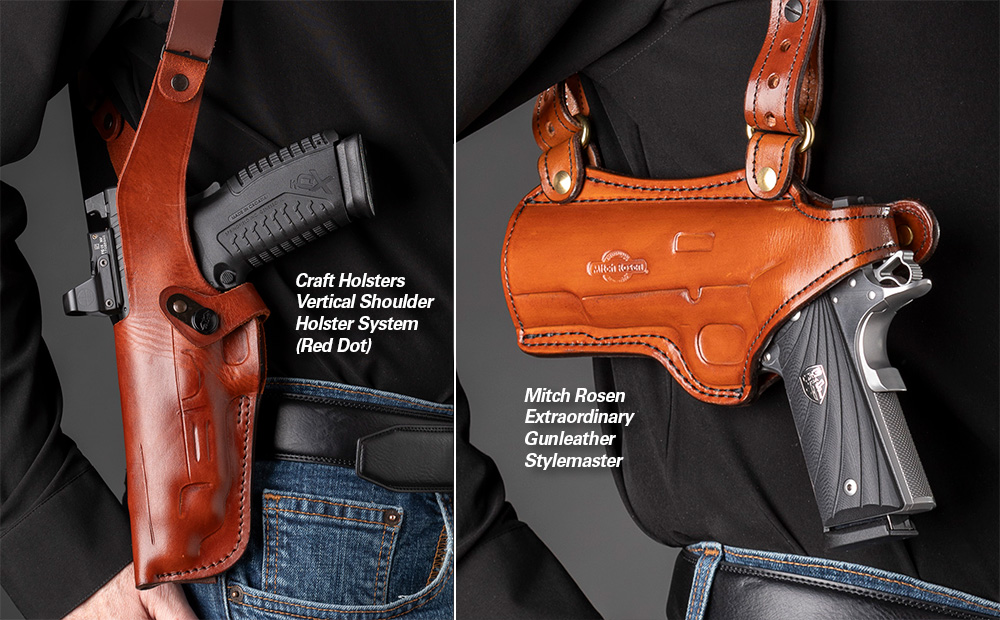
The most obvious consideration with shoulder carry is that, in order for it to be concealed, an additional layer (i.e., a coat or jacket) must be worn over your base layer, and it will need to stay on for the duration of your activity. Also, for the gun to be quickly accessible, that cover garment needs to open at the front—so appropriate clothing choices are a bit more limited. The heaviness of the cover obviously plays a role in how much the gun prints, with thicker, cold-weather coats working best, but I have also found that lighter, more formal jackets (blazers/sport coats/suits) are also up to the task, if sized correctly.
In order to present the gun, the support hand is used to sweep the overlaying clothing out of the way and pin it behind your body while the strong hand grasps and draws the firearm. Keeping the support hand held all the way behind your back reduces the possibility of accidentally covering it with the gun’s muzzle as you draw the gun. Retention on horizontal holsters is generally via a button-secured strap that is disengaged by pressing it against the body with the thumb; most vertical rigs have a strap that is flicked off by the trigger finger. Unlike many other modes of carry, bathroom visits do not present any special hardships, nor does driving or sitting for extended periods at a desk.
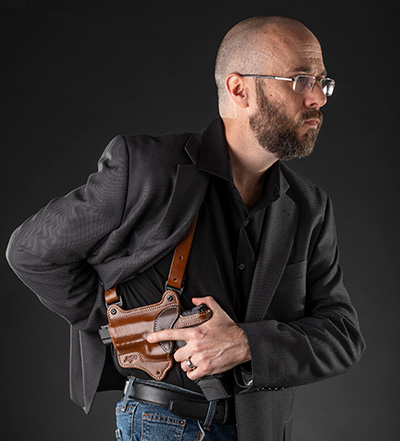
One potential drawback of a horizontal rig in particular is the unavoidable reality of your carry piece’s muzzle constantly pointing at anyone standing or walking behind you. Now, on the one hand, in all my years of firearm use I’ve never once encountered a gun that went off of its own volition without a human finger on the trigger, but, on the other, it’s perfectly understandable if you feel uneasy about occasionally flagging people without their knowledge. For those able to overcome this mental hurdle, however, I find that horizontal holsters do provide quicker and more ergonomic presentation of the gun, and they usually fit better as well. With some vertical rigs, I have found that lateral twisting of the firearm, with the frame then either jabbing me in the gut or swinging wide of it, can be an issue—although tying down to a belt does help alleviate this a bit.
Another consideration for both barrel orientations: Shoulder holsters are designed to conform to the human body while it is upright. If you lean too far forward while wearing one, your gun may dangle beyond its cover garment and become visible—although some rigs have an extra strap around the back that prevents this from becoming an issue.
For many, Galco is likely the company that first comes to mind when shoulder holsters are brought up, and for good reason—it was the offering that made the brand famous. The company currently still offers seven different models (six horizontal, one vertical) and its reputation for quality is well-deserved. In addition, I wore an Aker Flatsider XR7 for several years, and I’ve also had great personal success with the beautifully crafted and customizable Wright Leather Works Maverick. Recently, I sent my Cabot Southpaw off to Mitch Rosen Extraordinary Gunleather so the company could build a bespoke Stylemaster holster around this uniquely left-handed M1911. The results are, commensurate with the gun, top-notch and immaculate.
As far as vertical holsters are concerned, the ones that I’ve had the best experiences with have been Galco’s VHS 4.0 (which is offered for both semi-automatics and revolvers) and the Red Dot variant of Craft Holsters’ Vertical Shoulder Holster System—one of the few options on the market for optics-ready pistols. For those seeking extra versatility, the 1051 ALS from Safariland is an economical leather/Kydex hybrid holster that can be configured for either horizontal or vertical carry by simply re-positioning three screws.
Belly Bands
Until fairly recently, belly-band holsters were essentially just thought of as a way for women to carry while out doing their cardio, and, to be fair, not only is a belly band the single most comfortable way to carry while exercising, it is one of the few that are feasible at all. But, in recent years, holster companies have started taking the premise much more seriously, essentially as a variant on appendix carry. To be honest, I had never used a belly-band holster for a single second prior to starting the research for this story, but after a few months of regularly taking one along with me on my evening walks, and even occasionally around the office during the day, I get the appeal.
As is implied by the name, a belly-band holster consists of a large pliable strap that wraps around the wearer’s stomach, under a cover shirt, and is usually cinched tight against his or her body via panels of hook-and-loop fasteners. While a belly band absolutely can coexist with pants and a belt, it does not rely on either to stay put, which is what makes it so ideal for use during exercise—and also one of the better carry options for a woman wearing a belt-less outfit like a skirt.
Some simply have a single compartment into which the pistol is inserted, but most incorporate a number of other pockets that can also accommodate spare magazines, a flashlight, a knife and/or even your cellphone. Many are one-size-fits-most designs with tight elastic pockets sized for compatibility with a broad swath of the mouse guns, micro-compacts and snub-nose revolvers on the market, but some are refined enough to be model-specific—oftentimes with a formed Kydex shell providing an enhanced degree of retention.
Ironically, similarly to appendix, how workable you’re likely to find this method of carry to be, and how obviously your CCW is going to print, is probably directly contingent on the amount of belly that you carry with you out front. If you’ve got a big gut, a belly-banded gun is less concealed carry and more a billboard that there’s an oddly shaped item strapped to your stomach. I do think, however, that women have an advantage here, as a bra (I’m assuming) will significantly help disguise the lines of a holster/gun that is being carried on the belly.
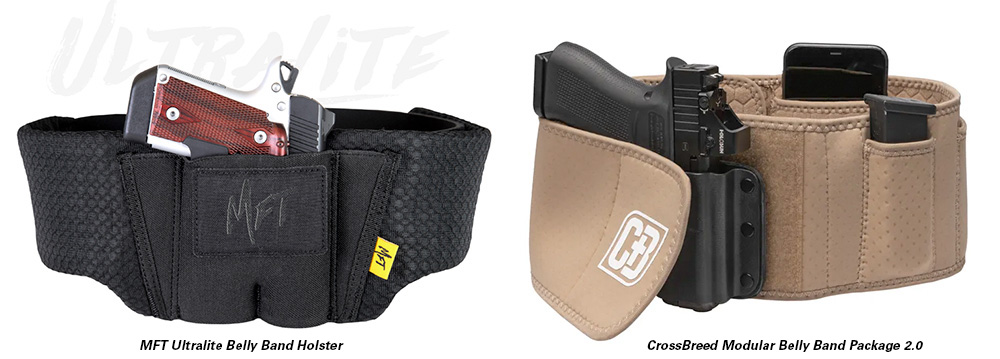
For highly fit individuals (assuming again, unfortunately), a pistol in a belly band should disappear pretty effectively. As a man whose physique could probably best be described as “dad bod lite,” I personally found that, unless the fit was extremely tight, concealment under a T-shirt or a polo was effective—just don’t tuck it in. And the use of a cover shirt with buttons or a pattern hid the holstered gun’s profile even more. At no point did I notice anyone “making” my carry gun while wearing an appropriate clothing choice.
While I obviously wouldn’t recommend doing cartwheels, during regular physical excursions like walking or jogging, I found the belly band to be a safe and secure manner of holding a gun; I could not get an unloaded pistol to dislodge itself from any of the test holsters by jumping up and down, running or bending over. Because they hold the gun up higher on the body than appendix carry, a belly band was considerably more pleasant after long stretches of time seated (like while working a desk job) and even allow for an easy seated draw—however, its position on the stomach does provide less room with which to clear the handgun’s muzzle of the holster during presentation.
Despite my back issues, I personally found the belly-band holsters to be surprisingly comfortable for all-day wear, although some pinching does occur, so an undershirt might not be a bad idea. With any holster carried for a long period of time, sweat is at least a minor concern; with a belly band, given how much of it is in tight contact with your body, this is much more of an issue—even if not being worn during exercise—and regularly airing out your rig is a definite must.
During the past few months, I’ve experimented with a half-dozen belly-band designs, and, generally speaking, despite their diminished versatility and somewhat higher cost, I’ve come to prefer those holsters that utilize a model-specific shell. Great examples I’ve found include CrossBreed’s Modular Belly Band Package 2.0 (also compatible with the company’s Purse Defender, Pac Mat and Bedside Backup systems) and Alien Gear’s Low-Pro Belly Band Holster, as not only do they offer more safe and secure carry of your gun, but also allow it to be held at a canted angle that provides a more ergonomic, comfortable draw. That being said, I also found that Mission First Tactical’s ambidextrous, one-size-fits-most Ultralite Belly Band Holster worked well with several of my subcompact semi-automatics and snubbie revolvers, and its trigger guard shield does add a greater measure of security than other similar designs.
Ankle Carry
An ankle rig is essentially just a cuff with a holster built into it that is tightened against the wearer’s calf. They are predominantly worn on the inside of the weak-side leg, so a holster for a right-handed user would hold the gun against the interior of the left leg—and vice versa. As with many other modes of concealed carry, there is a definite size limit beyond which ankle carry becomes impractical—particularly in regard to the gun’s height measurement. The frame must be short enough to fit within the pant leg without giving away its presence, although this is obviously somewhat dependent on the size of the user and the fit of the garment to a degree.
Of the three modes of carry described here, ankle rigs are by far the slowest when it comes to presentation of the firearm. In fact, it is among the slowest of all styles—so particular situational awareness would be prudent. Drawing requires kneeling or bending at the waist to retrieve the firearm, with your support hand pulling up the pant sleeve (which may be difficult to do cleanly under duress) as your strong hand draws. I have encountered some ankle holsters where the retention strap is disengaged by the trigger finger as the first step of the draw and others where it is detached via the thumb.
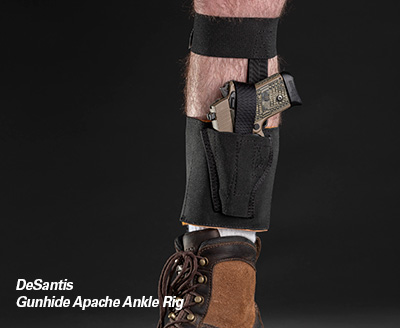
Ankle carry can take a bit of time to get used to, mostly just due to the awkwardness of having an extra couple of pounds affixed to one leg and not the other. It took me about a week to get to the point where I no longer noticed this. Running is probably not going to be practical, but walking was a surprisingly easy adjustment.
I have found, however, that no matter how snugly an ankle holster is secured against the calf, it will inevitably slide down to rest against the top of your shoe by the end of a long day if not periodically re-tightened. As a consequence of this, I find that boots or other types of high-top shoes work best for ankle carry, otherwise, depending on the length of your pant legs, by the end of the day, your holster may well be visible to bystanders. Alternately, some companies offer a support strap compatible with their ankle holsters that is attached higher up on the calf (serving the same function as a garter), which I found greatly helps counteract the holster’s tendency to migrate downward, although at the cost of being slightly less comfortable.
While an ankle holster does prevent a quick draw of your firearm, it does afford a fairly surreptitious one—as you can appear to be tying your shoelaces while actually drawing your gun. I suppose some may be tempted to bring the holster up to them rather than go down to it, but I think the notion of compromising your balance during a self-defense scenario is an exceedingly bad one.
Again, your clothing choices are greatly impacted by the decision to use an ankle holster, as you are not only forced into long pants, but relatively loose-fitting ones at that. The unfortunate modern trend of cigarette-legged pants ain’t going to cut it here—and even my “relaxed straight” jeans couldn’t accommodate an ankle rig with even a snubbie or a mouse gun. While I don’t think I would ever choose an ankle holster as my primary avenue of carry due to the inconvenient draw, it was surprisingly comfortable and easy on my back, which makes it a decent candidate for a back-up gun.
DeSantis Gunhide offers several ankle holsters of varying price and material composition, most of which are compatible with its Ankle Support Strap, and I found the company’s Apache Ankle Rig paired with this strap to be a combination that is not only economical but also gravity-resistant. Another great example of bang for the buck, the Leather Ankle Holster from MTR Custom Leather is offered in an uncommonly wide variety of firearm fits for an ankle rig (including many full-size models, if you can make that work for you) and is unexpectedly comfortable, thanks to memory-foam padding and a suede interior surface.
Final Thoughts
To reiterate, if you can make IWB work, you probably should. However, for those like me for whom this isn’t an option, you do have other alternatives, and it turns out that some of them are pretty solid. When the circumstances allow for it, with a shoulder rig, I am always loaded for bear; when they don’t, I don’t feel under-gunned or unprepared with a pocketed or belly-banded micro-compact at the ready. And, as we’ve seen, for each of the above methods of carry, quality holster options exist that can cater to pretty much any budget.
To me, the Armed Citizen column that appears each month in this magazine is exceptionally well-named. Without the innate right to self-defense, are we really citizens at all or just subjects to a government that we hope (foolishly) has our best interests at heart? And those of us who are forced away from the more popular modes of carry, for one reason or another, are no less deserving of capable concealed-carry options. The first rule of a gunfight is to always have a gun, and even if you find it necessary to adopt a less-than-ideal mode of carry, that doesn’t mean you have to abdicate your rights—the above three options can help keep you in the fight.












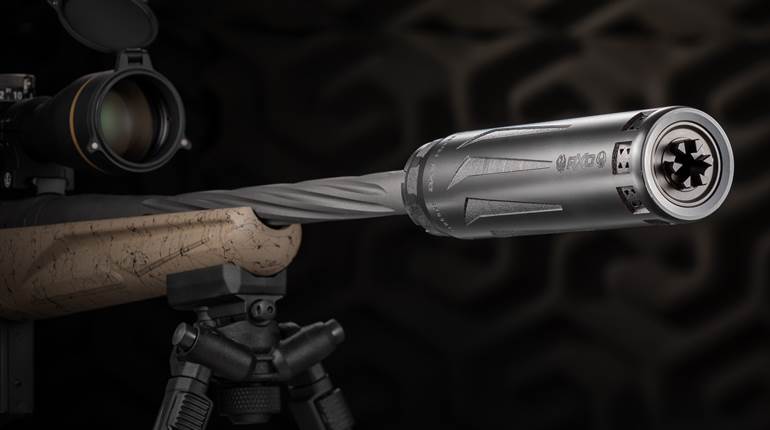
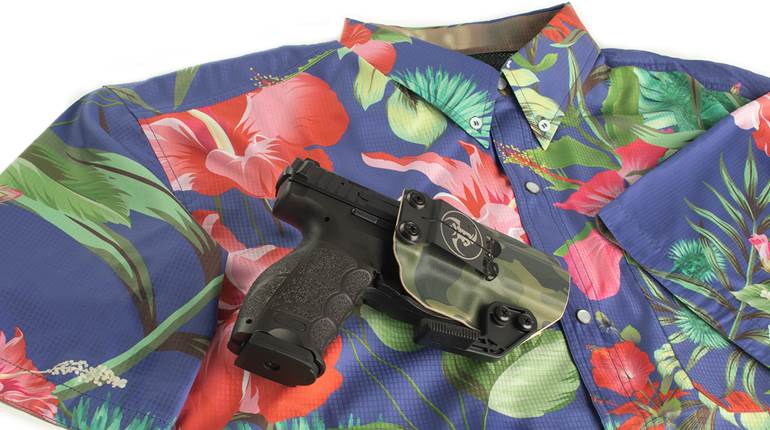
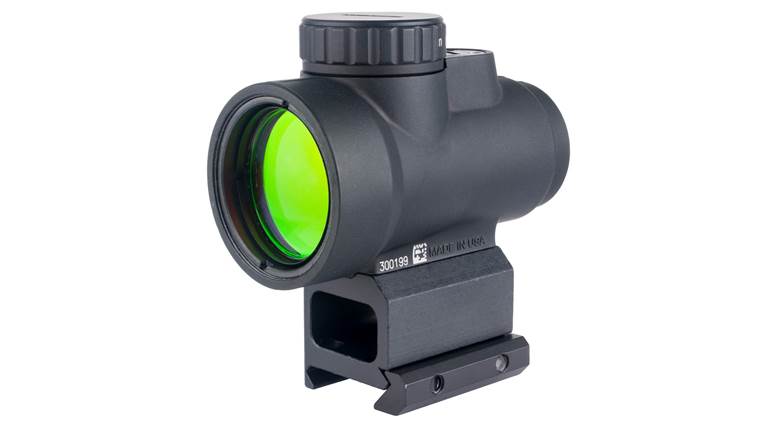



![Auto[47]](/media/121jogez/auto-47.jpg?anchor=center&mode=crop&width=770&height=430&rnd=134090788010670000&quality=60)
![Auto[47]](/media/121jogez/auto-47.jpg?anchor=center&mode=crop&width=150&height=150&rnd=134090788010670000&quality=60)
















